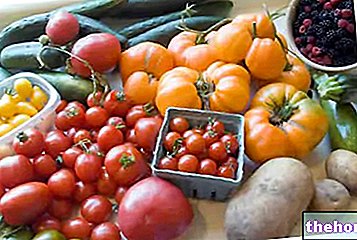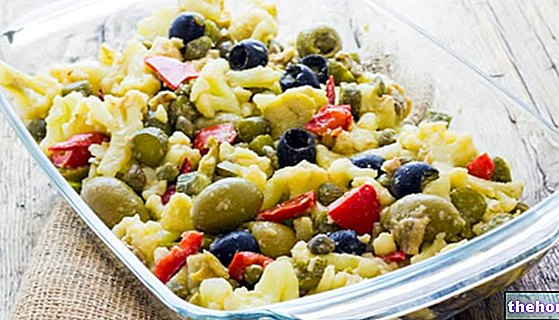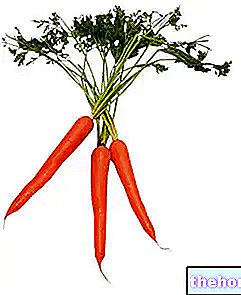Generality
The artichoke is a food of vegetable origin that belongs to the VII food group; in the kitchen you eat the flower (see recipes with artichokes), while the leaves and roots find other uses, especially in the phytotherapeutic field and in the liquor industry.

The Laon artichoke takes its name from the French region of the same name; the edible portion consists of the pulp of the external scales of the flower (bracts), the receptacle and the stem.
The culinary use of the Laon artichoke concerns: appetizers, side dishes, sauces and dishes.
Nutritional Characteristics
Like all artichokes, Laon's is also known for its nutritional properties and lends itself to any diet.
It is low in calories, mainly protein, has many soluble fibers and contains many minerals, vitamins and other beneficial molecules.
Thanks to the content of antioxidant polyphenols, it is widely used in nutritional therapy against metabolic diseases; in particular: hyperglycemia and type 2 diabetes mellitus, hypertriglyceridemia and hypercholesterolemia.
Inulin (soluble fiber) helps fight constipation, increases the perception of gastric satiety, modulates intestinal absorption (lowering the glycemic index and reducing lipid absorption) and acts as a probiotic by improving the intestinal bacterial flora. This makes the artichoke very useful in the diet of the obese, diabetic, hypercholesterolemic and hypertriglyceridemic.
The antioxidant polyphenol typical of artichokes is cynarin, a molecule known for its marked and multiple health functions. In particular, this compound seems to exert a protective and purifying role on the liver, improves cholesterolemia and stimulates bile flow.
NB: Thanks to the concentration of cynarin, the infusion of Laon artichoke leaves has marked cholagogue and choleretic (digestive) functions.
As for the saline and vitamin nutrients, the quantities of: iron, calcium, potassium and ascorbic acid (vit C) stand out.
The Laon artichoke is suitable for vegetarians, vegans, for lactose and gluten intolerance (celiac disease).
The medium portion varies according to the recipe. Assuming to use it as a side dish, considering that the edible portion is only 34%, the quantity of artichoke for an adult could be about 400-800g (140-280g of edible matter).
Laon Artichoke and Weight Loss
The Laon artichoke has recently been used in the production of dietary supplements aimed at slimming.
The reason for this choice is not clear; According to the slogan on the product label, this extract should act by "killing" fat cells.
First of all, the destruction of adipocytes is not an entirely desirable effect (adipose is a tissue with very important endocrine functions). Moreover, the Laon artichoke does not have a chemical composition such as to suggest any lipolytic effect.
The companies offer the Laon artichoke in the form of dry extract in capsules (cynarin, other polyphenols and inulin), to be taken daily with meals.
Ultimately, Laon artichoke-based food supplements have no slimming effect. They do not destroy adipocytes, do not mobilize fats from adipose tissue nor do they favor cellular lipolysis. In this context, it is a product to be avoided.
The only useful use could be as a source of polyphenols and inulin for:
- Reduce oxidative stress.
- Promote the restoration of altered metabolic parameters (cholesterol, blood sugar and triglyceridemia).
- Promote liver purification.
NB: all the effects listed can only be obtained in conjunction with an adequate diet and "regular motor activity."
Hints of Botany
The Laon artichoke belongs to the whole of raw green artichokes, to the Genus Cynara, to the species scolymus, to variety viridis and the sub-variety Laon.
It is grown mainly in the northern areas, where the climate is more rigid.
It has a good yield and, in particularly fertile soils, the flower reaches considerable dimensions (basal diameter of almost 15cm).
The bracts are not very open, not too long, pointed but obtuse and of a bright green color. They contain most of the edible portion. This pulp is fleshy, not too soft and attached to the non-digestible fibrous lamina.
Other Foods - Vegetables Garlic Agretti Asparagus Basil Beets Borage Broccoli Capers Artichokes Carrots Catalonia Brussels sprouts Cauliflower Cabbage and Savoy cabbage Red cabbage Cucumber Chicory Turnip greens Onion Sauerkraut Watercress Edamame Chives Chanterelles Flour Cassava Flowers Pumpkin Flour Edible Flowers Pumpkin Seasonal Fruits and Vegetables Endive Salads and Salads Strengthening Salad Lettuce Aubergines Vegetables Nettle Pak-Choi Parsnip Potatoes American Potato Peppers Pinzimonio Tomatoes Leeks Parsley Radicchio Turnips Red Turnips Radishes Rocket Shallots Endive Celery Celeriac Seeds Sprouted Spinach Truffle Valianamberi or Jerusalem artichoke laxatives Saffron Pumpkin Zucchini Vegetables - Nutritional properties OTHER VEGETABLE ITEMS Categories Food Alcoholics Meat Cereals and derivatives Sweeteners Sweets Offal Fruit Dried fruit Milk and derivatives Legumes Oils and fats Fish and fishery products Cold cuts S pezie Vegetables Health recipes Appetizers Bread, Pizza and Brioche First courses Second courses Vegetables and Salads Sweets and Desserts Ice creams and sorbets Syrups, liqueurs and grappa Basic preparations ---- In the kitchen with leftovers Carnival recipes Christmas recipes Light diet recipes Women's Day, Mum, Dad Recipes Functional Recipes International Recipes Easter Recipes Recipes for Celiacs Recipes for Diabetics Recipes for Holidays Recipes for Valentine's Day Recipes for Vegetarians Protein Recipes Regional Recipes Vegan Recipes



















-nelle-carni-di-maiale.jpg)








